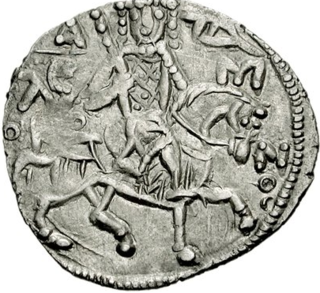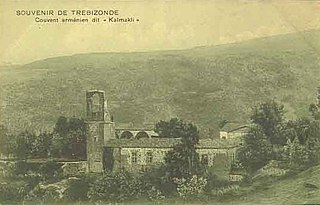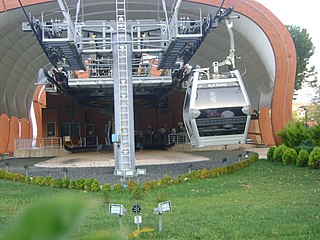
Trabzon, historically known as Trebizond, is a city on the Black Sea coast of northeastern Turkey and the capital of Trabzon Province. Trabzon, located on the historical Silk Road, became a melting pot of religions, languages and culture for centuries and a trade gateway to Persia in the southeast and the Caucasus to the northeast. The Venetian and Genoese merchants paid visits to Trabzon during the medieval period and sold silk, linen and woolen fabric. Both republics had merchant colonies within the city – Leonkastron and the former "Venetian castle" – that played a role to Trabzon similar to the one Galata played to Constantinople. Trabzon formed the basis of several states in its long history and was the capital city of the Empire of Trebizond between 1204 and 1461. During the early modern period, Trabzon, because of the importance of its port, again became a focal point of trade to Persia and the Caucasus.
This is an alphabetical index of people, places, things, and concepts related to or originating from the Byzantine Empire. Feel free to add more, and create missing pages. You can track changes to the articles included in this list from here.

The Empire of Trebizond, or Trapezuntine Empire, was a monarchy and one of three successor rump states of the Byzantine Empire, along with the Despotate of the Morea and the Principality of Theodoro, that flourished during the 13th through to the 15th century, consisting of the far northeastern corner of Anatolia and the southern Crimea. The empire was formed in 1204 with the help of the Georgian queen Tamar after the Georgian expedition in Chaldia and Paphlagonia, commanded by Alexios Komnenos a few weeks before the sack of Constantinople. Alexios later declared himself Emperor and established himself in Trebizond. Alexios and David Komnenos, grandsons and last male descendants of deposed Emperor Andronikos I Komnenos, pressed their claims as "Roman emperors" against Byzantine Emperor Alexios V Doukas. The later Byzantine emperors, as well as Byzantine authors, such as George Pachymeres, Nicephorus Gregoras and to some extent Trapezuntines such as John Lazaropoulos and Basilios Bessarion, regarded the emperors of Trebizond as the "princes of the Lazes", while the possession of these "princes" was also called Lazica. Thus from the point of view of the Byzantine writers connected with the Laskaris and later with the Palaiologos dynasties, the rulers of Trebizond were not emperors.
John VIII Xiphilinos, a native of Trebizond, was a Byzantine intellectual, jurist, and patriarch of Constantinople from 1064 to 1075. He was the uncle of John Xiphilinus, the Epimator. He is considered "an innovator in the field of the methodology of jurisprudential research."

Trabzon Province is a province of Turkey on the Black Sea coast. Located in a strategically important region, Trabzon is one of the oldest trade port cities in Anatolia. Neighbouring provinces are Giresun to the west, Gümüşhane to the southwest, Bayburt to the southeast and Rize to the east. İsmail Ustaoğlu was appointed the Governor of the province in October 2018.

Andronikos I Gidos, Latinized as Andronicus I Gidus or Gidon, was an Emperor of Trebizond (1222–1235). He is the only ruler of Trebizond who was not a blood relative of the founder of that state, Alexios I Megas Komnenos. George Finlay suggests he may be the same Andronikos who was a general of Theodore I Laskaris. During his reign, Trebizond successfully withstood a siege of the city by the Seljuk Turks, and later supported the Shah of Khwarizm in the latter's unsuccessful battle with the Seljuks.
Alexios I Megas Komnenos or Alexius I Megas Comnenus was, with his brother David, the founder of the Empire of Trebizond and its ruler from 1204 until his death in 1222. The two brothers were the only male descendants of the Byzantine Emperor Andronikos I, who had been dethroned and killed in 1185, and thus claimed to represent the legitimate government of the Empire following the conquest of Constantinople by the Fourth Crusade in 1204. Although his rivals governing the Nicaean Empire succeeded in becoming the de facto successors, and rendered his dynastic claims to the imperial throne moot, Alexios' descendants continued to emphasize both their heritage and connection to the Komnenian dynasty by later referring to themselves as Megas Komnenos.

Giresun, formerly Cerasus, is a city in the Black Sea Region of northeastern Turkey, about 175 km (109 mi) west of the city of Trabzon. It is the seat of Giresun Province and Giresun District. It has a population of 125,682 (2022).
Saint Eugenios or Eugene was martyred under Diocletian and a cult devoted to him developed in Trebizond. His feast day is 21 January. Eugenios along with the martyrs Candidus, Valerian and Aquila was persecuted during the reign of Diocletian (284-305) and Maximian (305-311). The four hid in the mountains above Trebizond, but were eventually found and brought before the regimental commander Lycius. They were flogged, tortured with fire and eventually beheaded. Eugenios is credited with the destruction of the image on the "gray hill" overlooking the city, later known as the Mithratis.

Sumela Monastery is a Greek Orthodox monastery dedicated to the Theotokos located at Karadağ within the Pontic Mountains, in the Maçka district of Trabzon Province in modern Turkey.

Hagia Sophia is a formerly Greek Orthodox church that was converted into a mosque in 1584. It is located in Trabzon, northeastern Turkey. It was converted into a museum in 1964 and back into a mosque in 2013. The building dates back to the thirteenth century, when Trabzon was the capital of the Empire of Trebizond. It is located near the seashore and two miles west of the medieval town's limits. It is one of a few dozen Byzantine sites extant in the area and has been described as being "regarded as one of the finest examples of Byzantine architecture".

Alexios II Megas Komnenos, was Emperor of Trebizond from 1297 to 1330. He was the elder son of John II and Eudokia Palaiologina.
David Komnenos was one of the founders of the Empire of Trebizond and its joint ruler together with his brother Alexios until his death. At least two lead seals and an inscription found on a tower in Heraclea Pontica attest that he was the first of his family to use the style Megas Komnenos. Ηe was the son of Manuel Komnenos and grandson of the Emperor Andronikos I.

The conversion of non-Islamic places of worship into mosques occurred during the life of Muhammad and continued during subsequent Islamic conquests and under historical Muslim rule. Hindu temples, Jain Temples, Christian churches, synagogues, and Zoroastrian fire temples have been converted into mosques.

Kaymaklı Monastery is a ruined Armenian Apostolic monastery near Trabzon, Turkey.

Boztepe or Mount Minthrion is a hill near Trabzon in Turkey. It is located 3 kilometers southeast of the city center of Trabzon. The Değirmendere Valley lies to the east of Boztepe. The Kaymaklı quarter occupies most of the Boztepe hill.

Theodora Komnene Kantakouzene was the Empress consort of Alexios III of Trebizond.

The Walls of Trabzon are a series of defensive walls surrounding the old town of the city of Trabzon, northeastern Turkey. The fortifications are sometimes called the Trabzon Castle. However, they did not function as a castle, rather as city walls. Constructed on foundations dating back to the Roman era with cut stones from former structures at site, the walls stretch from the hill on the backside of the old town to the Black Sea shore. The walls further divided the city into three parts; the Upper Town or "fortress", the Middle Town and the Lower Town. The upper and middle towns are flanked by steep ravines cut by the Zagnos (Iskeleboz) and Tabakhane (Kuzgun) streams to the west and east respectively, while the lower town extends to the west of Zagnos.

The Fatih Mosque is a mosque in Ortahisar district of Trabzon Province, Turkey. It was originally built in Byzantine times as the Panagia Chrysokephalos Church, serving as both the catholicon for the see of Trebizond, and a church for a monastery. It was built sometime in the 10th or 11th century. After Ottoman conquest of the city in 1461, the building became a mosque. The Fatih Mosque also displays the most beautiful samples of the Ottoman writing arts.
The siege of Trebizond in 1222–1223 was an unsuccessful siege of Trebizond, the capital of the namesake empire, by the Sultanate of Rum under a certain Melik. According to the late 14th-century Synopsis of Saint Eugenius of John Lazaropoulos, the city was close to being captured, but was saved by an unusually severe storm. The Seljuq assaults were repulsed, and their army was annihilated on its retreat through the attacks of the Matzoukaites, fierce mountain tribes under Trebizond's rule, and Melik was captured.

















